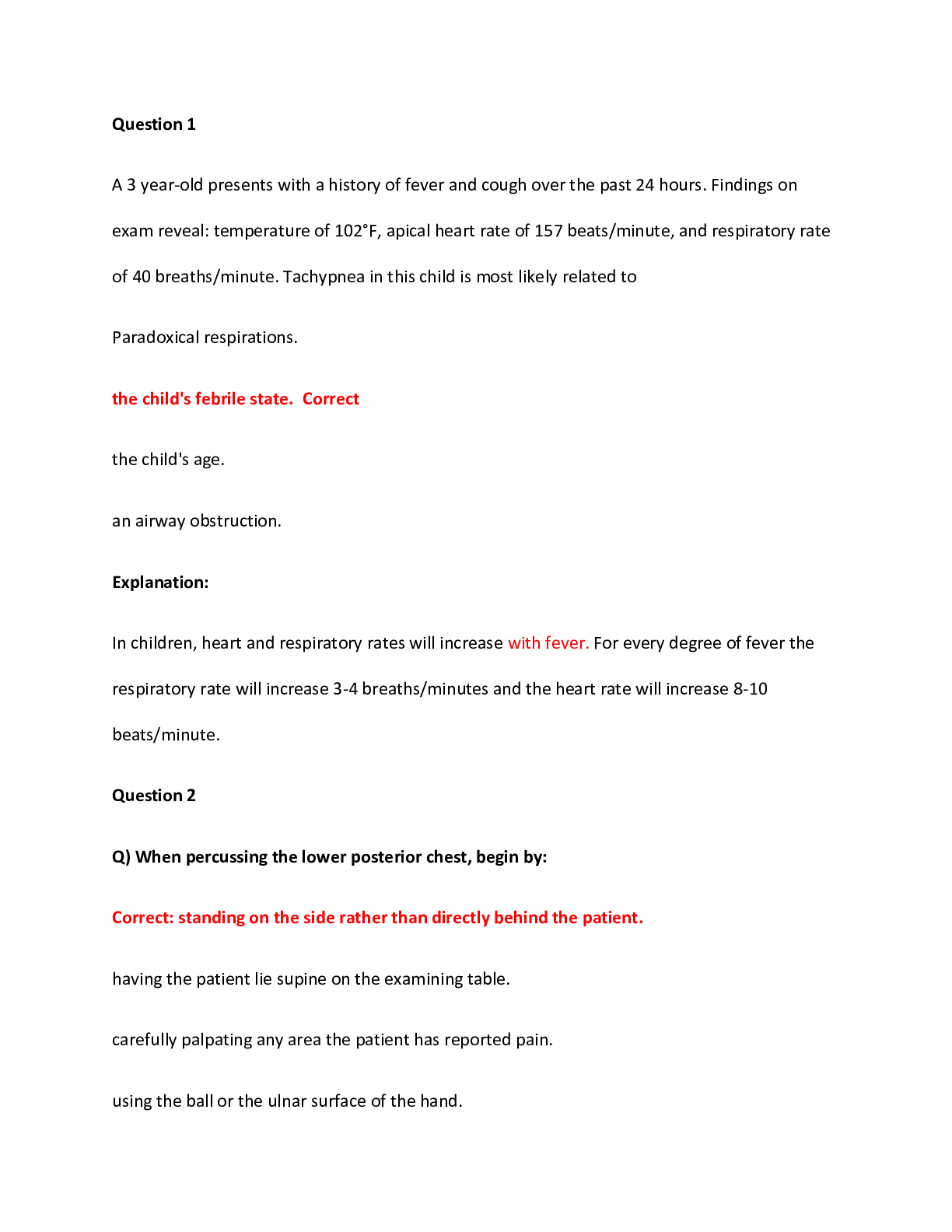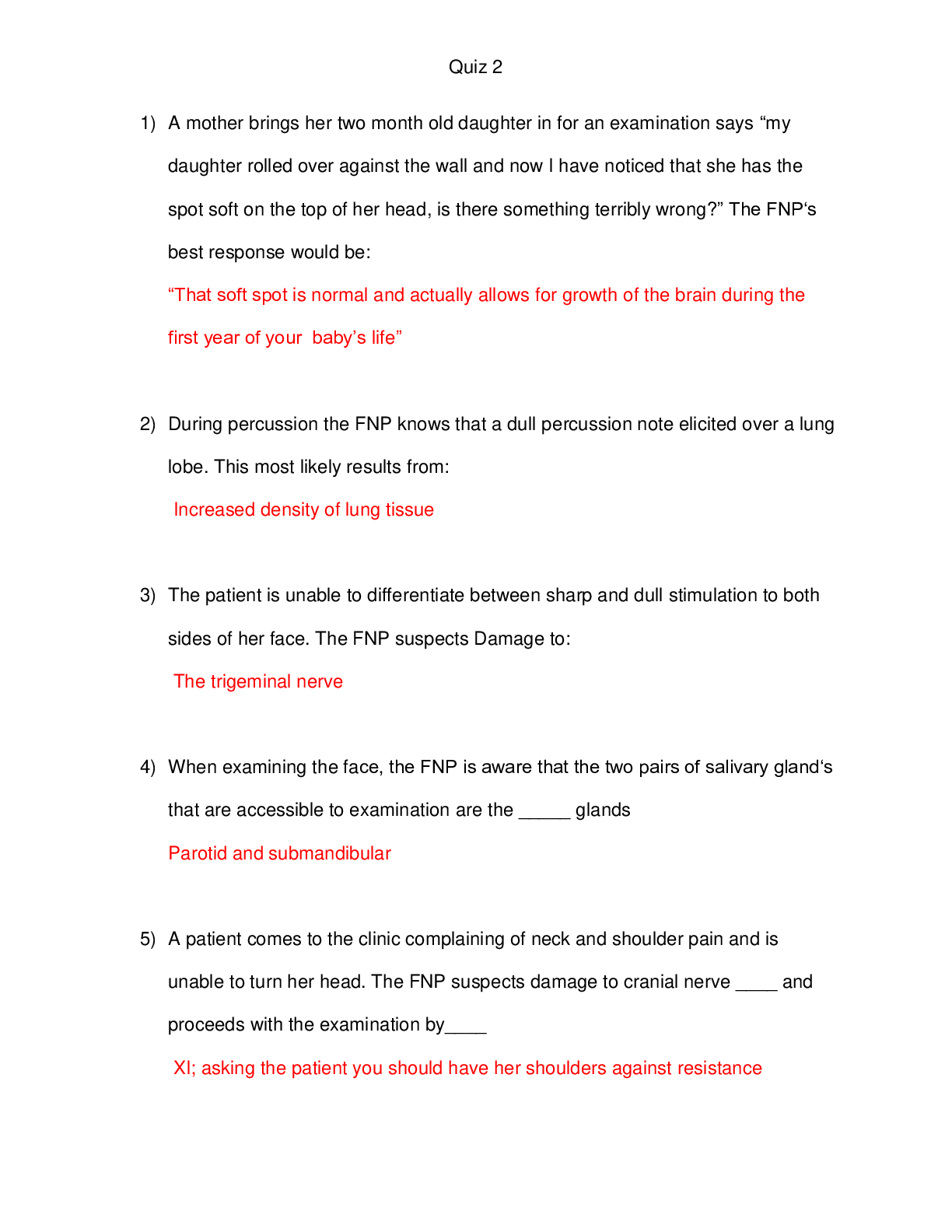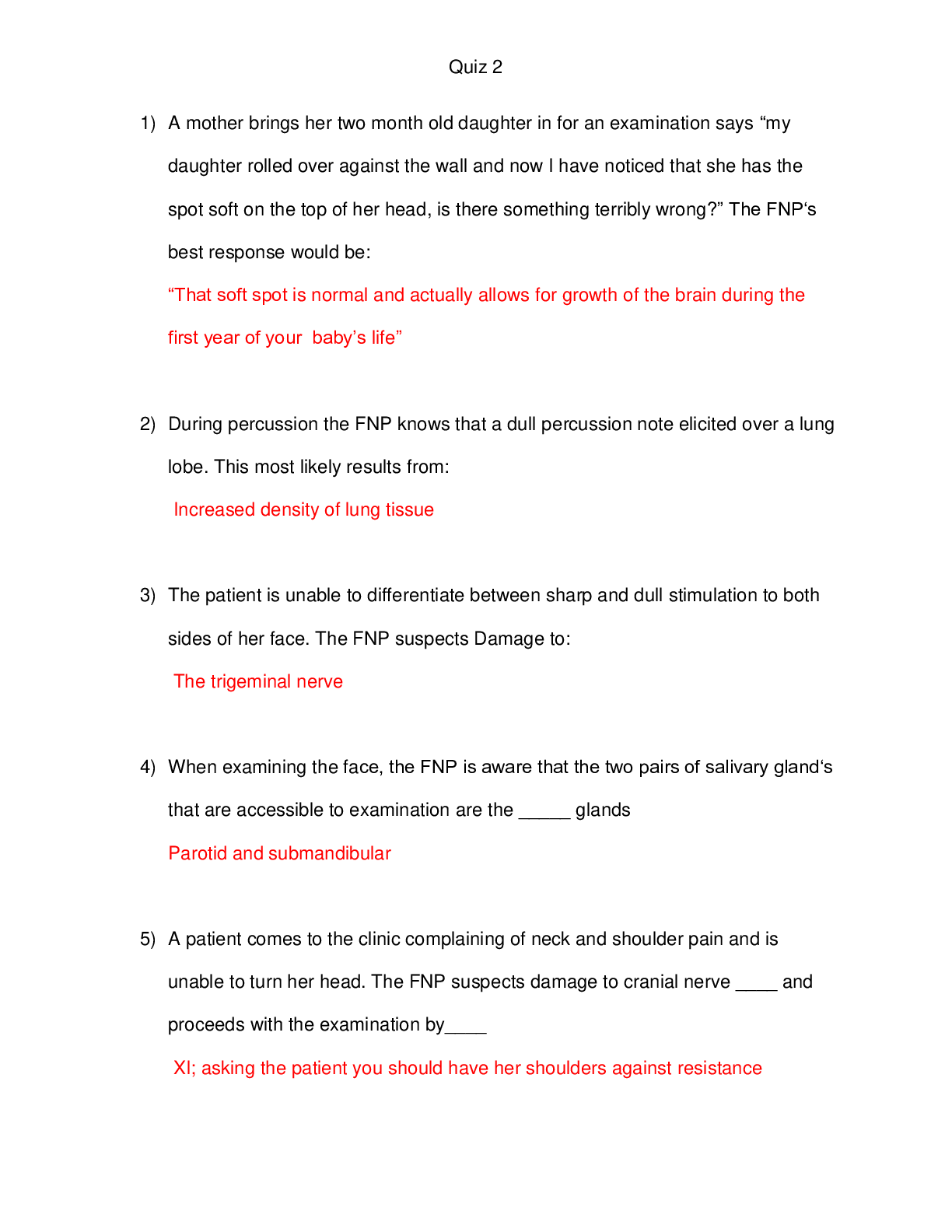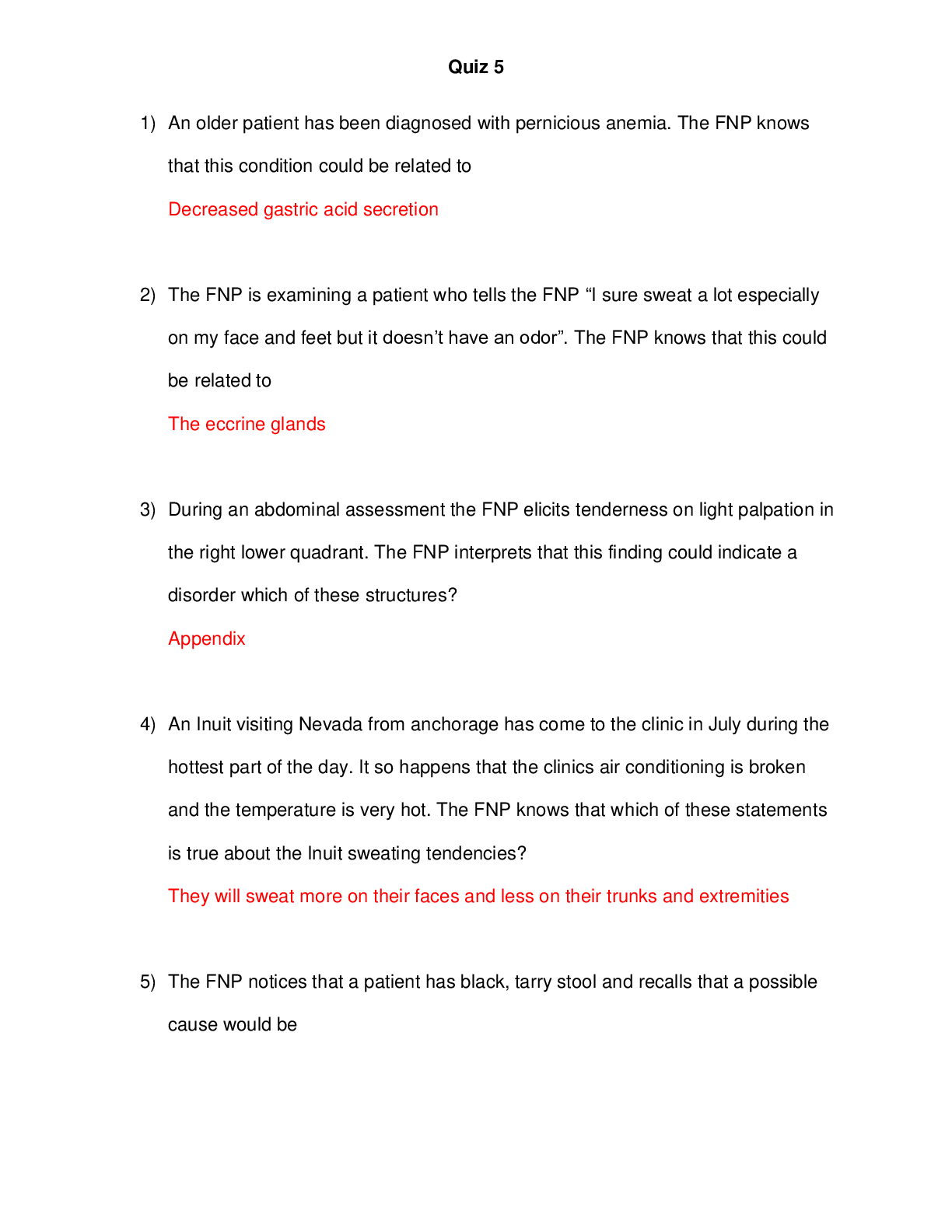*NURSING > QUESTIONS & ANSWERS > QUIZES 1-7 NR 509 Advanced Physical Assessment Chamberlain_ nr 509 quiz Already Passed (All)
QUIZES 1-7 NR 509 Advanced Physical Assessment Chamberlain_ nr 509 quiz Already Passed
Document Content and Description Below
NR 509 Week 1 Quiz: Questions & Answers 1. A patient tells the FNP that he is very nervous, that he is nauseated, and that he “feels hot”. This type of data would be: 2. The patient’s record, ... laboratory studies, objective data, and subjective data combine to form the: 3. The FNP is reviewing information about evidence-based practice. Which statement best reflects evidence-based practice? 4. A 59-year-old patient tells the FNP that he has ulcerative colitis. He has been having black stools for the last 24 hours. How would the FNP best document his reason for seeking care? 5. A 29-year-old woman tells the FNP that she has excruciating pain in her back. Which would be an appropriate response by the FNP to the woman statement? 6. In recording the childhood illnesses of a patient who denies having had any, which note by the FNP would be most accurate? 7. If a female patient tells the FNP that she has had six pregnancies, with four live births at term and two spontaneous abortions. Her four children are still living. How would the FNP record this information? 8. If a female patient tells the FNP that she has had six pregnancies, with four live births at term and two spontaneous abortions. Her four children are still living. How would the FNP record this information? 9. Which of these statements represents subjective data the FNP obtained from the patient regarding the patient’s skin? 10. The FNP is obtaining a history for a 30-year-old male patient and is concerned about health promotion activities. Which of these questions would be appropriate to use to assess health promotion activities for this patient? 11. Which statement indicates that the FNP understands the pain experienced by an elderly person? 12. The FNP is performing a vision examination. Which of these charts is most widely used for visual examination? 13. During a complete health assessment, how would the FNP test the patients hearing? 14. The FNP has just completed an examination of a patient’s extra-ocular muscles. When documenting the findings, the FNP should document the assessment of which cranial nerves? 15. A patient’s uvula rises midline when she says “ahh” and she has a positive gag reflex. The FNP has just tested which cranial nerve? 16. During an examination the FNP notices that a patient is unable to stick out his tongue. Which cranial nerve is involved with successful performance of this action? 17. A patient is unable to shrug her shoulders against the FNP‘s resistant hands. What cranial nerve is involved with successful shoulder shrugging? 18. During an examination, the patient has just successfully completed the finger to nose and rapid alternating movements test and is able to run each heel down the opposite shin. The FNP would conclude that the patient’s___ function is intact 19. A five-year-old child is in the clinic for checkup. The FNP would expect him to: 20. When the FNP performs the confrontation test the FNP has assessed: 21. Which of these statements is true regarding the complete physical assessment? 22. Which of these statements is true regarding recording of data from the history and physical examination? 23. Which of these is included in assessment of general appearance? 24. The FNP is performing a review of symptoms. Which of these questions are appropriate as Health promotion questions to ask during this time? 25. The FNP is incorporating a person’s spiritual values into the health history. Which of these questions illustrates the community portion of the FICA questions? 26. The FNP is preparing to complete a health assessment on a 16-year-old girl whose parents have brought her to the clinic. Which NR 509 All Quizzes Week 1 to 7 Advanced Physical Assessment Chamberlain Spring 2018 Dynamic Views theme. Powered by Blogger. Classic Flipcard Magazine Mosaic Sidebar Snapshot Timeslide NR 509 Advanced Physical Assessment Chamberlain search This study source was downloaded by 100000831988016 from CourseHero.com on 04-21-2022 12:02:23 GMT -05:00 https://www.coursehero.com/file/38070921/QUIZES-1-7-NR-509-Advanced-Physical-Assessment-Chamberlain-nr-509-quizpdf/ 11/4/2018 NR 509 Advanced Physical Assessment Chamberlain: nr 509 quiz http://nr509chamberlain.blogspot.com/search/label/nr%20509%20quiz 2/9 NR 509 Weekly Quizzes… NR 509 All Quizzes Ver… NR 509 Weekly Quizzes… NR 509 Musculoskeletal… NR 509 Week 1 Quiz Q… NR 509 Week 2 Quiz Ad… NR 509 Week 3 Quiz Pr… NR 509 Week 4 Quiz Ad… NR 509 Week 5 Quiz 2 … NR 509 Week 6 Quiz Pr… NR 509 Week 7 Quiz Pr… NR 509 Complete Cours… NR 509 All Quizzes We… instruction would be appropriate for the parents before the interview begins? NR-509 Week 2 Quiz: Questions & Answers 1. A mother brings her two month old daughter in for an examination says “my daughter rolled over against the wall and now I have noticed that she has the spot soft on the top of her head, is there something terribly wrong?” The FNP‘s best response would be: 2. During percussion the FNP knows that a dull percussion note elicited over a lung lobe. This most likely results from: 3. The patient is unable to differentiate between sharp and dull stimulation to both sides of her face. The FNP suspects Damage to: 4. When examining the face, the FNP is aware that the two pairs of salivary gland‘s that are accessible to examination are the _____ glands 5. A patient comes to the clinic complaining of neck and shoulder pain and is unable to turn her head. The FNP suspects damage to cranial nerve ____ and proceeds with the examination by____ 6. When examining a patient’s cranial nerve function, the FNP remembers that the muscles in the neck that are innervated by CN XI are the: 7. The patient’s laboratory data reveal an elevated thyroxine level. The FNP would proceed with an examination of the _____ gland 8. A patient says that she has recently noticed a lump in the front of her neck below her “Adams apple” that seems to be getting bigger. During the assessment, the finding that leaves the FNP to suspect that this may not be a cancerous thyroid nodule is that the lump: 9. The FNP notices that the patient’s submental lymph nodes are enlarged. In an effort to identify the cause of the node enlargement, the FNP would assess the patient’s: 10. The FNP is aware that the four areas in the body were lymph nodes accessible are the: 11. A 52-year-old patient describes the presence of occasional floaters or spots moving in front of his eyes. The FNP should know that floaters are usually not significant and are caused by: 12. The FNP is preparing to assess the visual acuity of a 16-year-old patient. How should the FNP proceed? 13. A patient’s vision is recorded as 20/30 when the Snellen eye chart is used. The FNP interprets these results to indicate that: 14. A patient is unable to read even the largest letters on the Snellen chart. The FNP should take which action next: 15. A patient’s vision is reported as 20/80 in each eye. The FNP interprets this finding to mean that 16. When performing the corneal light reflex assessment, the FNP notes that the light is reflected at 2 o’clock in each eye. The FNP should 17. The FNP is performing the diagnostic positions test. Normal findings would be which of these results? 18. During an assessment of the sclera of an African-American patient, the FNP would consider which of these an expected finding? 19. A 60-year-old man is at the clinic for an examination. The FNP suspects that he has ptosis of one eye. How should the FNP check for this? 20. The FNP is doing an assessment on a 21-year-old patient and notices that his nasal mucosa appears pale gray and swollen. What would be the most appropriate question to ask the patient? 21. The FNP is palpating the sinus areas. If the findings are normal, then the patient should report which sensation? 22. During an oral assessment of a 30-year-old African-American patient, the FNP notices bluish lips and a dark line along the gingival margin. What would the FNP do in response to these findings 23. During an assessment of a 20-year-old patient with a three day history of nausea and vomiting the FNP notices dry mucous and deep vertical fissures on the tongue. These findings are reflective of: 24. The FNP is reviewing the technique of palpating for tactile fremitus with a new graduate. Which statement by the graduate FNP reflects a correct understanding of tactile fremitus? 25. The FNP student is reviewing physical assessment findings of the HEENT system associated with pregnancy. Which statement by the graduate FNP reflects a correct understanding of expected HEENT changes associated with pregnancy? During pregnancy: NR 509 Week 2 Quiz Review – (Jarvis 8,9,13,14,15,16,18), (Swartz 4,6,7,8,9,10) 1. What does dullness when percussing lung fields: Jarvis pg 427 2. Facial sensation controlled by which CN: Jarvis 283, 3. Know what two salivary glands are accessible during exam 4. What CN is being … when pt shrugs shoulders Jarvis 646 5. What muscles are being …. when …. CN 11 (spinal accessory nerve) 6. Concern for malignant nodules versus benign lymph nodule 7. Know what you’d do next if you palpated a submental lymph node: Jarvis pg 253 8. Define visual acuity 9. Know what to do if your patient can’t read the largest number on the Snellen chart: Jarvis 289 10. Example of good visual acuity : Jarvis 289 11. Example of poor visual acuity: Jarvis 289 12. What is …. with corneal light reflex13. Know normal variances of sclera : Jarvis 283 14. Know how to check for Ptosis: Jarvis 292 Dynamic Views theme. Powered by Blogger. Classic Flipcard Magazine Mosaic Sidebar Snapshot Timeslide search This study source was downloaded by 100000831988016 from CourseHero.com on 04-21-2022 12:02:23 GMT -05:00 https://www.coursehero.com/file/38070921/QUIZES-1-7-NR-509-Advanced-Physical-Assessment-Chamberlain-nr-509-quizpdf/ 11/4/2018 NR 509 Advanced Physical Assessment Chamberlain: nr 509 quiz http://nr509chamberlain.blogspot.com/search/label/nr%20509%20quiz 3/9 NR 509 Weekly Quizzes… NR 509 All Quizzes Ver… NR 509 Weekly Quizzes… NR 509 Musculoskeletal… NR 509 Week 1 Quiz Q… NR 509 Week 2 Quiz Ad… NR 509 Week 3 Quiz Pr… NR 509 Week 4 Quiz Ad… NR 509 Week 5 Quiz 2 … NR 509 Week 6 Quiz Pr… NR 509 Week 7 Quiz Pr… NR 509 Complete Cours… NR 509 All Quizzes We… 15. What does ptosis indicate: Jarvis 292 16. Nasal fissure of pt with chronic allergies : Jarvis 271 Acute allergies : Jarvis p 363 . 17. What is an abnormal palpation of sinuses: Jarvis 362 Normal palpation of sinuses 18. Know normal variations in gingival margin 19. Know what a dehydrated oral cavity will look like: Jarvis 387 20. What is tactile fremitus, how do you test for it and what does it indicate. Jarvis 425 NR 509 Week 2 Quiz Review & Study Guide (Jarvis 8,9,13,14,15,16,18), (Swartz 4,6,7,8,9,10) NR 509 Week 3 Quiz: Questions & Answers 1. A teenage girl has arrived complaining of pain in her left wrist. She was playing basketball when she fell and landed on her left hand. The FNP examined her hand and will expect a fracture if the girl complains: 2. A patient has been diagnosed with osteoporosis and asked the FNP “what is osteoporosis?” The FNP explains to the patient that osteoporosis is defined as: 3. Patient states, “I can hear a crunching or grating sound when I kneel”. She also states “that it is very difficult to get out of bed in the morning because of stiffness and pain in my joints”. The FNP should assess for signs of what problem? 4. When taking the history on a patient with a seizure disorder the FNP assesses whether the patient has an aura. Which of these would be the best question for obtaining this information? 5. The FNP is teaching a class on osteoporosis prevention to a group of post menopausal women. A participant shows that she needs more instruction when she states I will: 6. The FNP is performing a neurological assessment on a 41-year-old woman with a history of diabetes. When testing her ability to feel the vibrations of a tuning fork the FNP notices that the patient is unable to feel vibrations on the great toe or ankle bilaterally, but she is able to feel vibrations on both patella. Given this information what would the FNP suspect? 7. And 80-year-old woman is visiting the clinic for a check up. She states “I can’t walk as much as I used to”. The FNP is observing from motor dysfunction in her hip and should have her: 8. The FNP is testing the function of cranial nerve XI. Which of these best describes the response the FNP should expect if the nerve is intact? The patient: 9. A 50-year-old woman is in a clinic for weakness in her left arm and leg that she noticed for the past week. The FNP should perform which type of neurologic examination? 10. During the neurological assessment of a healthy 35-year-old patient the FNP asks him to relax his muscles completely. The FNP then moves each extremity through full range of motion. Which of these results would the FNP expect to find? 11. A woman who is 8 months pregnant comments that she has noticed a change in posture and is having lower back pain. The FNP tells her that during pregnancy women have a posture shift to compensate for the enlarging fetus. This shift and posture is known as: 12. A patient is able to flex his right arm forward without difficulty or pain but is unable to abduct his arm because of pain and muscle spasm’s. The FNP should suspect: 13. A professional tennis player comes into the clinic complaining of a sore elbow. The FNP will assess for tenderness at the: 14. The FNP suspect that a patient has carpal tunnel syndrome and wants to perform the Phalens test. To perform this task the FNP should instruct the patient to: 15. During the history a patient tells the FNP that “it feels like the room is spinning around me”. The FNP would document this as: 16. The assessment of a 60-year-old patient has taken longer than anticipated. In testing his pain perception the FNP decides to complete the test as quickly as possible. When the FNP applies the sharp point of a pin on his arm several times he is only able to identify these as one very sharp prick. What would be the most accurate explanation for this? 17. An 85-year-old patient comments during his annual physical that “he seems to be getting shorter as he ages”. The FNP should explain that decrease height occurs with aging because: 18. A patient is complaining of pain in his joints that is worse in the morning, is better after he has moved around for a while, and then gets worse again if he sits for long periods of time. The FNP should assess for other signs of what problem? 19. When the FNP asks a 68-year-old patient to stand with feet together and arms at his side with his eyes closed he starts to sway and moves his feet farther apart. The FNP would document this finding as: 20. During an assessment of the cranial nerves the FNP finds the following asymmetry when the patient smiles or frowns, uneven lifting of eyebrows, sagging of lower eyelids, and escape of air when the FNP presses against the right path cheek. This would indicate dysfunction of which of these cranial nerves? 21. The FNP is teaching a class on osteoporosis prevention to a group of postmenopausal women which of these actions is the best way to prevent or delay bone loss in this group? 22. In obtaining a history on a 74 year old patient the FNP notes that he drinks alcohol daily and that he has noticed a tremor in his hands that affects his ability to hold thing. With this information what should the FNP‘s response be? 23. During a history of a 78-year-old man his wife states that “he occasionally has problems with short-term memory loss and confusion. He can’t even remember how to button his shirt”. In doing the assessment of his sensory system which action of the FNP‘s is most appropriate? 24. While obtaining a history of a 3 month old infant from the mother the FNP asks about the infants ability to suck and grass the mothers finger. What is the FNP assessing? 25. The FNP is doing an assessment on a 29-year-old woman who visits the clinic complaining of always dropping things and falling down. While testing rapid alternating movements the FNP notices that the woman is unable to pat both her knees. Her Dynamic Views theme. Powered by Blogger. Classic Flipcard Magazine Mosaic Sidebar Snapshot Timeslide search This study source was downloaded by 100000831988016 from CourseHero.com on 04-21-2022 12:02:23 GMT -05:00 https://www.coursehero.com/file/38070921/QUIZES-1-7-NR-509-Advanced-Physical-Assessment-Chamberlain-nr-509-quizpdf/ 11/4/2018 NR 509 Advanced Physical Assessment Chamberlain: nr 509 quiz http://nr509chamberlain.blogspot.com/search/label/nr%20509%20quiz 4/9 NR 509 Weekly Quizzes… NR 509 All Quizzes Ver… NR 509 Weekly Quizzes… NR 509 Musculoskeletal… NR 509 Week 1 Quiz Q… NR 509 Week 2 Quiz Ad… NR 509 Week 3 Quiz Pr… NR 509 Week 4 Quiz Ad… NR 509 Week 5 Quiz 2 … NR 509 Week 6 Quiz Pr… NR 509 Week 7 Quiz Pr… NR 509 Complete Cours… NR 509 All Quizzes We… response is very slow and she misses frequently. What should the FNP suspect? 26. NR-509 Week 4 Quiz: Questions & Answers 1. A 35-year-old man is seen in the clinic for an infection in his left foot. Which of these findings should the FNP expect to see during an assessment of this patient? 2. The direction of blood flow through the heart is best described by which of these 3. In assessing the carotid artery’s of an older patient with cardiovascular disease, the FNP would 4. When listening to heart sounds the FNP knows that the valve closures that can be heard best at the base of the heart are 5. The sack that surrounds and protects the heart is called the 6. When assessing a newborn infant who is five minutes old the FNP knows that which of these statements would be true? 7. The FNP is performing an assessment on an adult. The adults vital signs are normal and capillary refill is five seconds. What should the FNP do next? 8. During an assessment of an older adult the FNP should expect to notice which finding as normal physiologic change associated with aging process? 9. The mother of a three month old infant states that her baby has not been gaining weight. With further questioning the FNP finds that the infant falls asleep after nursing and wakes up after a short amount of time hungry again. What other information with the FNP want to have? 10. In assessing a patient’s major risk factors for heart disease which would the FNP want to include when taking a history? 11. The FNP is … the pulses of a patient who has been admitted for untreated hyperthyroidism. The FNP should expect to find a____pulse 12. A patient complains of leg pain that wakes him at night. He states that he has been having problems with his legs. ….. his legs when they are … and disappears when he dangles them. He recently noticed a sore on the inner aspect of his right ankle. On the basis of this history information the FNP interprets that the patient is most likely experiencing 13. During an assessment the FNP uses the profile sign to detect 14. Which of these statements describes the closure of the valves in a normal cardiac cycle? 15. When performing a peripheral vascular assessment on a patient the FNP is unable to palpate the ulnar pulses. The patient skin is warm and capillary refill is normal. The FNP should next 16. A 67-year-old patient states that he “recently began have pain in his left calf when climbing the 10 stairs to his apartment”. This pain is relieved by sitting for about two minutes then he’s able to resume activities. The FNP interprets this patient is most likely experiencing 17. In assessing a 70-year-old man the FNP finds the following blood pressure 140/100 mmHg, heart rate 104 and slightly irregular, split S2. Which of these findings can… by expected hemodynamic changes related to age? 18. The FNP is examining the lymphatic system of a healthy three year old child. Which finding should the FNP expect? 19. The FNP is preparing to perform modified Allen test. Which is an appropriate reason for this test? 20. A 25-year-old woman is in her fifth month of pregnancy has a blood pressure of 100/70 mmHg. In reviewing her previous exam the FNP notes that her blood pressure in her second month was 124/80 mmHg. When evaluating this change what does the FNP know to be true? 21. Findings from an … of a 70-year-old patient with swelling in his ankles include jugular venous pusations, 5 cm above the sternal angle when the head of his bed is …. 45°. The FNP knows that this finding indicate: 22. The component of the conduction system referred to as the pacemaker of the heart is the 23. The FNP is reviewing anatomy and physiology of the heart. Which statement best … by atrial kick? 24. A 45-year-old man is in the clinic for a routine physical. During history the patient states he has been having difficulty sleeping. I’ll be sleeping great and then I wake up and feel like I can’t catch my breath. The FNP‘s best response to this would be 25. When assessing a patient the FNP notes that the left femoral pulse as diminished 1+/4+. What should the FNP do next? 1. NR 509 Week 3 Quiz (Version 2) 1. What piece of equipment can be used to test for peripheral neuropathy 2. How would you test for Romberg sign 3. Diagnosis for patient with complaint of room spinning 4. Know expected postural changes in pregnancy 5. Know what the phalen’s test is and how to conduct it 6. Hands back to back for 60 secs looking for development of 7. Positive Phalen’s test 8. Older pt that can’t remember to tie shoes in order to assess this you first want to? 9. What is loss of bone density 10. Disease that is accompanied by joint pain in the morning that improves with movement and worsens with sitting 11. What is summation effect and what does it mean 12. Know what is normal findings in passive ROM 13. … evaluate a pt with migraines in regard to if they have an aura 14. Know abnormal finding of rotator cuff 15. Know the type of neuro exam to complete on a pt presenting with one sided weakness 16. Understand tennis elbow 17. Know common reflexes at various ages 18. What tremors improve with ETOH Dynamic Views theme. Powered by Blogger. Classic Flipcard Magazine Mosaic Sidebar Snapshot Timeslide search This study source was downloaded by 100000831988016 from CourseHero.com on 04-21-2022 12:02:23 GMT -05:00 https://www.coursehero.com/file/38070921/QUIZES-1-7-NR-509-Advanced-Physical-Assessment-Chamberlain-nr-509-quizpdf/ 11/4/2018 NR 509 Advanced Physical Assessment Chamberlain: nr 509 quiz http://nr509chamberlain.blogspot.com/search/label/nr%20509%20quiz 5/9 NR 509 Weekly Quizzes… NR 509 All Quizzes Ver… NR 509 Weekly Quizzes… NR 509 Musculoskeletal… NR 509 Week 1 Quiz Q… NR 509 Week 2 Quiz Ad… NR 509 Week 3 Quiz Pr… NR 509 Week 4 Quiz Ad… NR 509 Week 5 Quiz 2 … NR 509 Week 6 Quiz Pr… NR 509 Week 7 Quiz Pr… NR 509 Complete Cours… NR 509 All Quizzes We… 19. Understand CN 11 20. What concerns exist when pt is slow with RAM 21. R/O MS 22. Know education for pts on exercises that help to prevent osteoporosis 23. What does hip abduction reveal NR 509 Week 4 Quiz (25 Points) 1. Question: A 35-year-old man is seen in the clinic for an infection in his left foot. Which of these findings should the FNP expect to see during an assessment of this patient? 2. Question: The direction of blood flow through the heart is best described by which of these 3. Question: In assessing the carotid artery’s of an older patient with cardiovascular disease, the FNP would 4. Question: When listening to heart sounds the FNP knows that the valve closures that can be heard best at the base of the heart are 5. Question: The sack that surrounds and protects the heart is called the 6. Question: When assessing a newborn infant who is five minutes old the FNP knows that which of these statements would be true? 7. Question: The FNP is performing an assessment on an adult. The adults vital signs are normal and capillary refill is five seconds. What should the FNP do next? 8. Question: During an assessment of an older adult the FNP should expect to notice which finding as normal physiologic change associated with aging process? 9. Question: The mother of a three month old infant states that her baby has not been gaining weight. With further questioning the FNP finds that the infant falls asleep after nursing and wakes up after a short amount of time hungry again. What other information with the FNP want to have? 10. Question: In assessing a patient’s major risk factors for heart disease which would the FNP want to include when taking a history? 11. Question: The FNP is assessing the pulses of a patient who has been admitted for untreated hyperthyroidism. The FNP should expect to find a____pulse 12. Question: A patient complains of leg pain that wakes him at night. … states that he has been having problems with his legs. He has pain in his legs when they are … and disappears when he dangles them. He recently noticed a sore on the inner aspect of his right ankle. On the basis of this history information the FNP interprets that the patient is most likely experiencing 13. Question: During an assessment the FNP uses the profile sign to detect 14. Question: … these statements describes the closure of the valves in a normal cardiac cycle? 15. Question: When performing a peripheral vascular assessment on a patient the FNP is unable to palpate the ulnar pulses. The patient skin is warm and capillary refill is normal. The FNP should next 16. Question: A 67-year-old patient states that he “recently began have pain in his left calf when climbing the 10 stairs to his apartment”. This pain is relieved by sitting for about two minutes then he’s able to resume activities. The FNP interprets this patient is most likely experiencing 17. Question: In assessing a 70-year-old man the FNP finds the following blood pressure 140/100 mmHg, heart rate 104 and slightly irregular, split S2. Which of these findings can … explained by expected hemodynamic changes related to age? 18. Question: The FNP is examining the lymphatic system of a healthy three year old child. Which finding should the FNP expect? 19. Question: The FNP is preparing to perform modified Allen test. Which is an appropriate reason for this test? 20. Question: A 25-year-old woman is in her fifth month of pregnancy has a blood pressure of 100/70 mmHg. In reviewing her previous exam the FNP notes that her blood pressure in her second month was 124/80 mmHg. When evaluating this change what does the FNP know to be true? 21. Question: Findings from an assessment of a 70-year-old patient with swelling in his ankles include jugular venous pusations, 5 cm above the sternal angle when the head of his bed is … 45°. The FNP knows that this finding indicate: 22. Question: The component of the conduction system referred to as the pacemaker of the heart is the 23. Question: The FNP is reviewing anatomy and physiology of the heart. Which statement best describes what is … by atrial kick? 24. Question: A 45-year-old man is in the clinic for a routine physical. During history the patient states he has been having difficulty sleeping. I’ll be sleeping great and then I wake up and feel like I can’t catch my breath. The FNP‘s best response to this would be 25. Question: When assessing a patient the FNP notes that the left femoral pulse as diminished 1+/4+. What should the FNP do next? NR 509 Week 5 Quiz: Questions & Answers 1. An older patient has been diagnosed with pernicious anemia. The FNP knows that this condition could be related to 2. ….. examining a patient who tells the FNP “I sure sweat a lot especially on my face and feet but it doesn’t have an odor”. The FNP knows that this could … related to 3. During an abdominal assessment the FNP elicits tenderness on light palpation in the right lower quadrant. The FNP interprets that this finding could indicate a disorder which of these structures? Dynamic Views theme. Powered by Blogger. Classic Flipcard Magazine Mosaic Sidebar Snapshot Timeslide search This study source was downloaded by 100000831988016 from CourseHero.com on 04-21-2022 12:02:23 GMT -05:00 https://www.coursehero.com/file/38070921/QUIZES-1-7-NR-509-Advanced-Physical-Assessment-Chamberlain-nr-509-quizpdf/ 11/4/2018 NR 509 Advanced Physical Assessment Chamberlain: nr 509 quiz http://nr509chamberlain.blogspot.com/search/label/nr%20509%20quiz 6/9 NR 509 Weekly Quizzes… NR 509 All Quizzes Ver… NR 509 Weekly Quizzes… NR 509 Musculoskeletal… NR 509 Week 1 Quiz Q… NR 509 Week 2 Quiz Ad… NR 509 Week 3 Quiz Pr… NR 509 Week 4 Quiz Ad… NR 509 Week 5 Quiz 2 … NR 509 Week 6 Quiz Pr… NR 509 Week 7 Quiz Pr… NR 509 Complete Cours… NR 509 All Quizzes We… 4. An Inuit visiting Nevada from anchorage has come to the clinic in July during the hottest part of the day. It so happens that the clinics air conditioning is broken and the temperature is very hot. The FNP knows that which of these statements is true about the Inuit sweating tendencies? 5. The FNP notices that a patient has black, tarry stool and recalls that a possible cause would … 6. ….. an abdominal …. deep palpation is used to determine 7. The FNP is assessing the abdomen of an aging adult. Which of these statements regarding an aging adult and abdominal assessment is true? 8. During examination the FNP finds that a patient has excessive dryness of the skin. The best term to describe this condition is 9. A FNP notices that a patient has ascites, which indicates the presence of 10. The FNP is performing percussion during an abdominal assessment. Percussion notes during the abdominal assessment may include 11. The FNP is caring for a black child who has … with marasmus. The FNP would expect to find the 12. … patient’s medical record that the patient has a lesion that is confluent in nature. On examination the FNP would expect to find 13. The FNP is assessing the abdomen of a pregnant woman who is complaining of having acid indigestion all the time. The FNP knows that esophageal reflux during pregnancy can cause 14. The patient has abdominal borborygmi. The FNP knows that this term refers to 15. A patient has a terrible itch for several months that he … scratching continuously. On examination the FNP might expect to find 16. During aging process, the hair can look gray or white and begin to feel thin and fine. The FNP knows that this occurs because of a decrease in number of functioning 17. The FNP notices that a patient has a solid, elevated, circumscribed lesion that is less than 1 cm in diameter. When documenting this finding the FNP would report this as a 18. During an abdominal assessment the FNP would consider which of these findings as normal? 19. A 52 -year-old Woman has a papule on her nose that has a rounded pearly border and a central red ulcer. She said she first noticed it several months ago and that it is slowly growing larger. The FNP suspects which condition? 20. The FNP is listening to bowel sounds. Which of these statements is true about bowel sounds? 21. The FNP is watching a new graduate FNP perform auscultation of a patient abdomen. Which statement by the new graduate shows a correct understanding of the reason auscultation proceeds percussion and palpitation of the abdomen? 22. A patient is complaining of a sharp pain along the costovertebral angles. The FNP knows that this symptom is most often indicative of 23. The patient is … of having inflammation of the gallbladder or cholecystitis. The FNP should conduct which of these techniques to assess for this condition? 24. A newborn infant is in the clinic for a well baby check. The FNP observes the infant for possibility of fluid loss because of which these factors? 25. During an assessment of a newborn infant, the FNP recalls that pyloric stenosis would … manifested by 26. NR 509 Week 5 Quiz: Skin, Hair, Abdomen 1. Question: The FNP is assessing the abdomen of an aging adult. Which of these statements regarding the agind adult and abdominal assessment is true? 2. Question: The FNP notices that a patient has had a black tarry stool and recalls that a possible cause would be 3. Question: The FNP knows that during an abdominal assessment deep palpitation is used to determine 4. Question: A patient has abdominal borboygmi. The FNP knows that this term refers to 5. Question: During an abdominal assessment, the FNP would consider which of these findings as normal? 6. Question: The FNP is caring for a black child who has been diagnosed with marasmus. The FNP would expect to find the 7. Question: An Inuit visiting Nevada from Anchorage has come to the clinic in July during the hottest part of the day. It so happens that the clinic’s air conditioning is broken and the temperature is very hot. The FNP knows that which of these statements is true about the Inuit sweating tendencies? 8. Question: The FNP is performing percussion during an abdominal assessment. Percussion notes heard during the abdominal assessment may include: 9. Question: During an abdominal assessment, the FNP elicits tenderness on light palpation in the right lower quadrant. The FNP interprets that this finding could indicate a disorder of which of these structures? 10. Question: A patient has a terrible itch for several months that he has been scratching continuously. On examination, the FNP might expect to find 11. Question: The FNP is listening to bowel sounds. Which of these statements is true of bowel sounds? 12. Question: A patient is complaining of a sharp pain along the costovertebral angles. The FNP knows that this symptom is most often indicative of 13. Question: The FNP notices that a patient has a solid, elevated, circumscribed lesion that is less than 1 cm in diameter. When documenting this finding, the FNP would report this as a 14. Question: A patient [Show More]
Last updated: 1 year ago
Preview 1 out of 9 pages
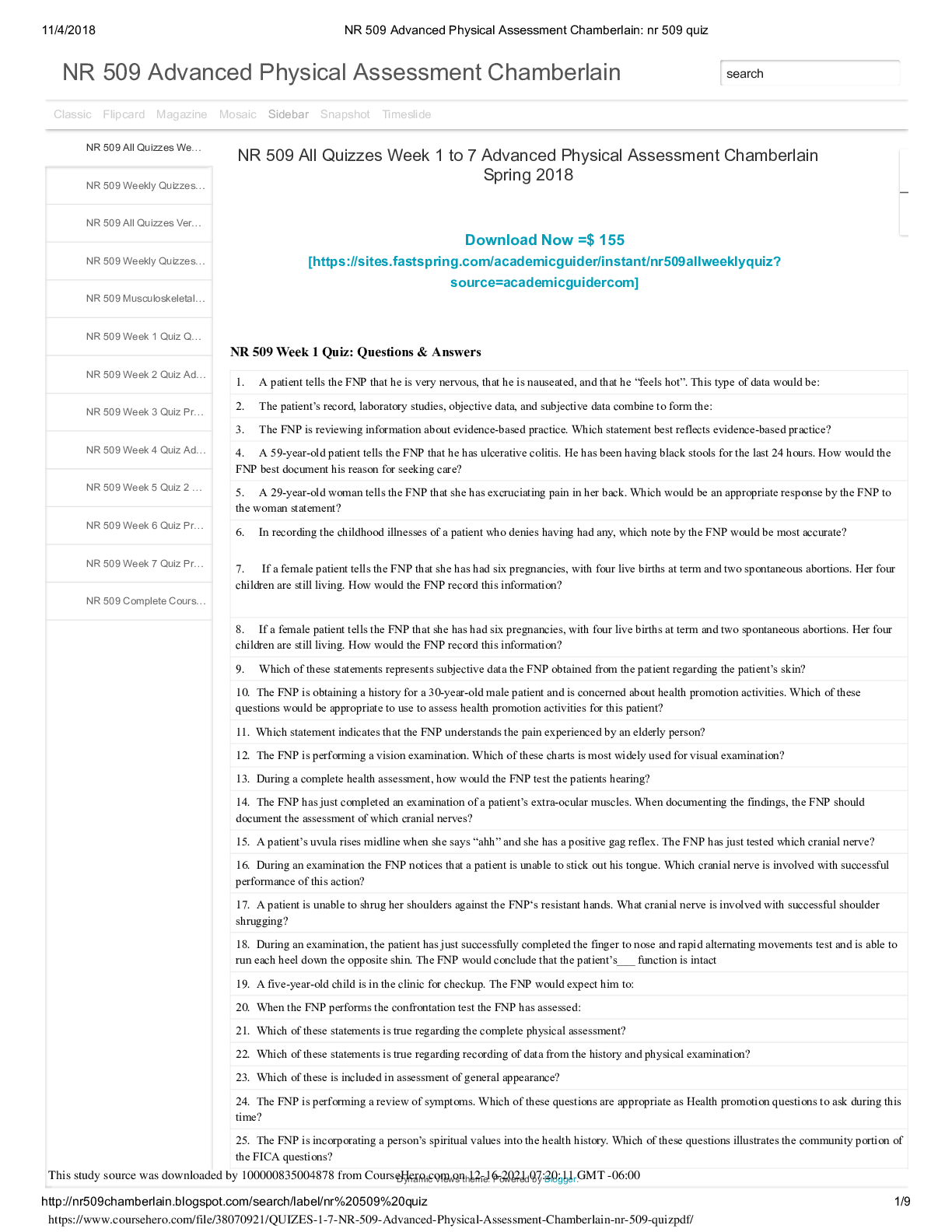
Buy this document to get the full access instantly
Instant Download Access after purchase
Add to cartInstant download
We Accept:

Reviews( 0 )
$13.00
Document information
Connected school, study & course
About the document
Uploaded On
Apr 21, 2022
Number of pages
9
Written in
Additional information
This document has been written for:
Uploaded
Apr 21, 2022
Downloads
0
Views
174

.png)
.png)
.png)
.png)
.png)
.png)
.png)
.png)
.png)
.png)
.png)

.png)
.png)
.png)
.png)
.png)

